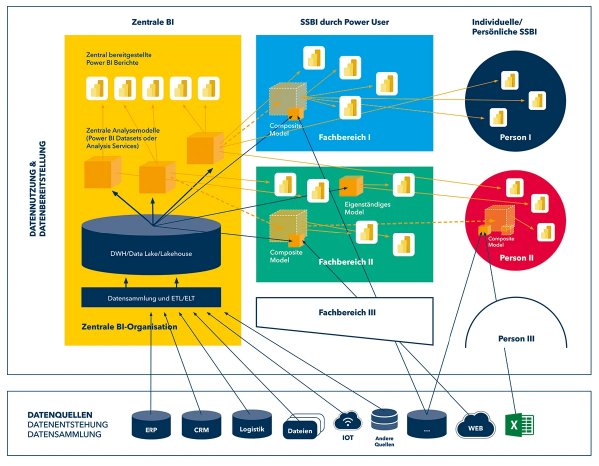The use case
Every Microsoft Power BI report developer or "power user" is familiar with the following situation: A new Power BI dashboard or report is to be created based on a Power BI dataset provided centrally by BI or IT departments. In the best case scenario, this dataset is already optimally suited for the report question at hand and, in addition to the required data in the appropriate granularity, also contains centrally secured and coordinated logics for the key figures to be evaluated. Nevertheless, it often happens that a few additional pieces of information are missing in the dataset for the requested report. There are many conceivable use cases for such small extensions to a central dataset, which are required at short notice for certain reports and ad-hoc analyses and may even be needed only temporarily:
- Individual groupings of customers, products, etc. in the form of calculated columns in the corresponding dimension tables of the central model or as an extension via additional tables that can be related to specific keys of an existing dimension table of the central model.
- Plan and forecast values from planning tools are to be imported and related to the central dimensions and thus to the actual values from the central model.
- Benchmark values from the internet, web service based sources, etc.
- Import of individually created threshold values that can be used in DAX logics for ABC, Pareto analyses, etc.
- ...
As a power user, however, one has no authorization to extend the central dataset due to data governance aspects. Although the required extension might even be relatively easy to implement (e.g. as a simple, additional calculated column in an existing table for an additional aggregation or as an additional fact table for benchmark values), this is not included (fast enough) in the central dataset for certain reasons. Examples of such reasons are:
- In the short term, IT staff or IT specialists do not have spare capacity to extend the central dataset.
- The extension would be irrelevant for most other dataset users, would only confuse them and jeopardize the acceptance of the central dataset.
- The extension is only temporarily relevant for a few ad-hoc analyses and becomes obsolete again after some time. It would then either have to be removed again with additional effort or would remain as a "corpse" in the analysis model.
- According to the IT experts, the enhancement must be installed "cleanly" and this would take several days/weeks, including the work in the central data warehouse. Again, this creates a conflict regarding priorities and resource availability in the central BI department.
- ...
Read Marco Nielinger's full article in nc360°, the noventum info platform:
What are Composite Models?
How do Composite Models work?
Areas of application for composite models
For more information about noventum BI consulting, please visit our website or read further articles on our info platform nc360°.


